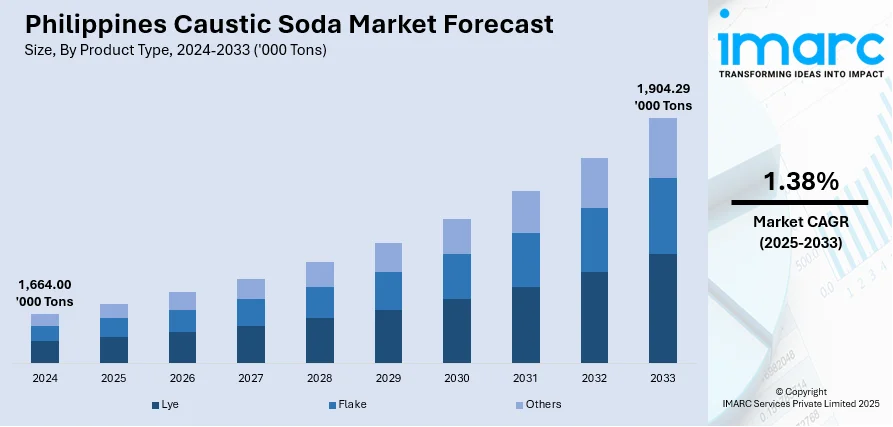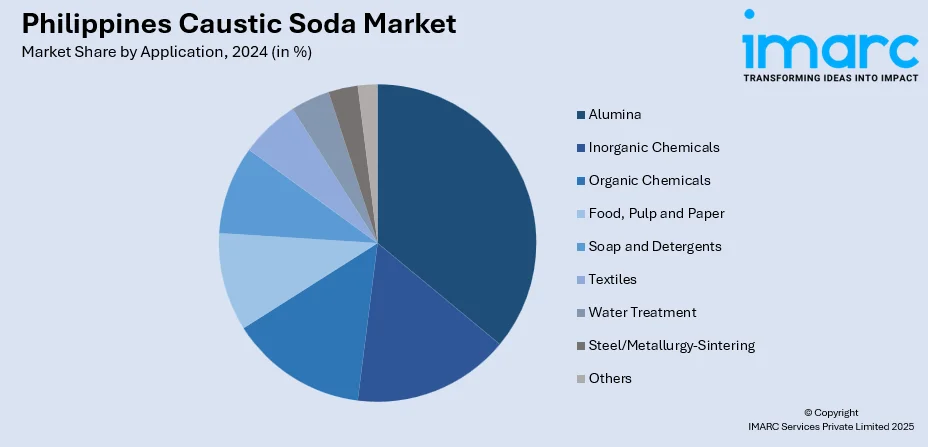
Philippines Caustic Soda Market Size, Share, Trends and Forecast by Product Type, Manufacturing Process, Grade, Application, and Region, 2025-2033
Philippines Caustic Soda Market Overview:
The Philippines caustic soda market size reached 1,664.00 Thousand Tons in 2024. The market is projected to reach 1,904.29 Thousand Tons by 2033, exhibiting a growth rate (CAGR) of 1.38% during 2025-2033. The market is fueled by the rising demand for caustic soda across key industries, supported by the country’s expanding manufacturing base. Moreover, increasing utilization in water treatment and food processing further strengthens consumption. Apart from this, the implementation of government initiatives to enhance infrastructure and the expansion of chemical production capacities are significant factors augmenting the Philippines caustic soda market share.
|
Report Attribute
|
Key Statistics
|
|---|---|
|
Base Year
|
2024
|
|
Forecast Years
|
2025-2033
|
|
Historical Years
|
2019-2024
|
| Market Size in 2024 | 1,664.00 Thousand Tons |
| Market Forecast in 2033 | 1,904.29 Thousand Tons |
| Market Growth Rate 2025-2033 | 1.38% |
Philippines Caustic Soda Market Trends:
Rising Demand from the Pulp and Paper Industry
The pulp and paper industry has emerged as a significant consumer of caustic soda, driven by the country’s expanding packaging and printing sectors. Industry reports project that the e-commerce sector will reach USD 24 Billion by 2025, reflecting a 17% growth rate from 2021. This rapid expansion, coupled with the rising preference for sustainable packaging alternatives, is driving higher production of paper and paperboard products. Caustic soda plays a crucial role in pulping, bleaching, and wastewater treatment processes, making it indispensable for the industry. Furthermore, with the government’s emphasis on reducing plastic use and promoting eco-friendly packaging alternatives, domestic paper production is expected to expand considerably. Local manufacturers are also investing in modernization and capacity enhancement to meet rising consumption, which directly translates into higher demand for caustic soda. Additionally, the Philippines imports a large portion of pulp and paper raw materials, and the presence of integrated facilities further drives caustic soda utilization for recycling processes. This rising dependency on caustic soda as a processing chemical positions the pulp and paper sector as a key driver of market growth.

To get more information on this market, Request Sample
Expanding Applications in the Alumina and Water Treatment Industries
Caustic soda is witnessing rising adoption in the Philippines due to its vital role in alumina refining and water treatment applications. The country’s alumina industry, though relatively smaller compared to global leaders, is gaining traction due to increasing investment in the mining and processing of bauxite and related minerals. Caustic soda is used extensively in extracting alumina from bauxite, which in turn serves as a raw material for aluminum production, essential for construction, transportation, and packaging industries. Besides this, water treatment applications are contributing strongly to market demand. According to industry reports, the population of the Philippines is approximately 116.9 Million as of mid-2025. Accelerated urbanization and steady population growth are intensifying challenges related to wastewater management and the provision of safe drinking water. Municipal bodies and industrial facilities are adopting caustic soda for pH regulation, heavy metal precipitation, and neutralization processes. Additionally, stricter environmental regulations and government-backed initiatives on water infrastructure modernization are further fueling caustic soda consumption. The convergence of industrial refining needs and the rising necessity for clean water systems underscores this trend’s long-term significance.
Increasing Use in Soap, Detergents, and Chemical Manufacturing
The expanding role in soap, detergent, and broader chemical manufacturing industries is propelling the Philippines caustic soda market growth. With the country’s population growth and heightened awareness of hygiene practices, particularly following the COVID-19 pandemic, the demand for cleaning and personal care products has surged. Caustic soda is a critical input in the saponification process for soap production and is also widely employed in the formulation of detergents and household cleaning products. Besides this, the growing middle-class population and rising disposable incomes are further stimulating the consumption of branded and premium cleaning solutions, which require higher production capacities from manufacturers. Beyond consumer products, caustic soda also serves as a feedstock in the production of various chemicals, including solvents, plastics, and synthetic fibers, supporting diverse downstream industries. Local producers are increasingly investing in process optimization and chemical diversification, ensuring sustained demand for caustic soda. This trend highlights its central role in supporting essential industries tied directly to consumer and industrial growth.
Philippines Caustic Soda Market Segmentation:
IMARC Group provides an analysis of the key trends in each segment of the market, along with forecasts at the country and regional levels for 2025-2033. Our report has categorized the market based on product type, manufacturing process, grade, and application.
Product Type Insights:
- Lye
- Flake
- Others
The report has provided a detailed breakup and analysis of the market based on the product type. This includes lye, flake, and others.
Manufacturing Process Insights:
- Membrane Cell
- Diaphragm Cell
- Others
A detailed breakup and analysis of the market based on the manufacturing process have also been provided in the report. This includes membrane cell, diaphragm cell, and others.
Grade Insights:
- Reagent Grade
- Industrial Grade
- Pharmaceutical Grade
- Others
The report has provided a detailed breakup and analysis of the market based on the grade. This includes reagent grade, industrial grade, pharmaceutical grade, and others.
Application Insights:

- Alumina
- Inorganic Chemicals
- Organic Chemicals
- Food, Pulp and Paper
- Soap and Detergents
- Textiles
- Water Treatment
- Steel/Metallurgy-Sintering
- Others
A detailed breakup and analysis of the market based on the application have also been provided in the report. This includes alumina, inorganic chemicals, organic chemicals, food, pulp and paper, soap and detergents, textiles, water treatment, steel/metallurgy-sintering, and others.
Regional Insights:
- Luzon
- Visayas
- Mindanao
The report has also provided a comprehensive analysis of all the major regional markets, which include Luzon, Visayas, and Mindanao.
Competitive Landscape:
The market research report has also provided a comprehensive analysis of the competitive landscape. Competitive analysis such as market structure, key player positioning, top winning strategies, competitive dashboard, and company evaluation quadrant has been covered in the report. Also, detailed profiles of all major companies have been provided.
Philippines Caustic Soda Market News:
- In October 2024, Mabuhay Vinyl Corporation (MVC), the Philippines' sole chlor-alkali producer, announced the completion of a PHP 630 Million expansion at its Iligan City plant, increasing production capacity by 68%. The upgrade strengthens MVC’s capacity to deliver key raw materials—such as chlorine and caustic soda—to sectors like water treatment, paper manufacturing, and cleaning products. It also expands marine tanker capabilities and enhances depot infrastructure, improving the reach and reliability of distribution across the country.
Philippines Caustic Soda Market Report Coverage:
| Report Features | Details |
|---|---|
| Base Year of the Analysis | 2024 |
| Historical Period | 2019-2024 |
| Forecast Period | 2025-2033 |
| Units | Thousand Tons |
| Scope of the Report |
Exploration of Historical Trends and Market Outlook, Industry Catalysts and Challenges, Segment-Wise Historical and Future Market Assessment:
|
| Product Types Covered | Lye, Flake, Others |
| Manufacturing Processes Covered | Membrane Cell, Diaphragm Cell, Others |
| Grades Covered | Reagent Grade, Industrial Grade, Pharmaceutical Grade, Others |
| Applications Covered | Alumina, Inorganic Chemicals, Organic Chemicals, Food, Pulp and Paper, Soap and Detergents, Textiles, Water Treatment, Steel/Metallurgy-Sintering, Others |
| Regions Covered | Luzon, Visayas, Mindanao |
| Customization Scope | 10% Free Customization |
| Post-Sale Analyst Support | 10-12 Weeks |
| Delivery Format | PDF and Excel through Email (We can also provide the editable version of the report in PPT/Word format on special request) |
Key Questions Answered in This Report:
- How has the Philippines caustic soda market performed so far and how will it perform in the coming years?
- What is the breakup of the Philippines caustic soda market on the basis of product type?
- What is the breakup of the Philippines caustic soda market on the basis of manufacturing process?
- What is the breakup of the Philippines caustic soda market on the basis of grade?
- What is the breakup of the Philippines caustic soda market on the basis of application?
- What is the breakup of the Philippines caustic soda market on the basis of region?
- What are the various stages in the value chain of the Philippines caustic soda market?
- What are the key driving factors and challenges in the Philippines caustic soda market?
- What is the structure of the Philippines caustic soda market and who are the key players?
- What is the degree of competition in the Philippines caustic soda market?
Key Benefits for Stakeholders:
- IMARC’s industry report offers a comprehensive quantitative analysis of various market segments, historical and current market trends, market forecasts, and dynamics of the Philippines caustic soda market from 2019-2033.
- The research report provides the latest information on the market drivers, challenges, and opportunities in the Philippines caustic soda market.
- Porter's five forces analysis assist stakeholders in assessing the impact of new entrants, competitive rivalry, supplier power, buyer power, and the threat of substitution. It helps stakeholders to analyze the level of competition within the Philippines caustic soda industry and its attractiveness.
- Competitive landscape allows stakeholders to understand their competitive environment and provides an insight into the current positions of key players in the market.
Need more help?
- Speak to our experienced analysts for insights on the current market scenarios.
- Include additional segments and countries to customize the report as per your requirement.
- Gain an unparalleled competitive advantage in your domain by understanding how to utilize the report and positively impacting your operations and revenue.
- For further assistance, please connect with our analysts.
 Request Customization
Request Customization
 Speak to an Analyst
Speak to an Analyst
 Request Brochure
Request Brochure
 Inquire Before Buying
Inquire Before Buying




.webp)




.webp)












